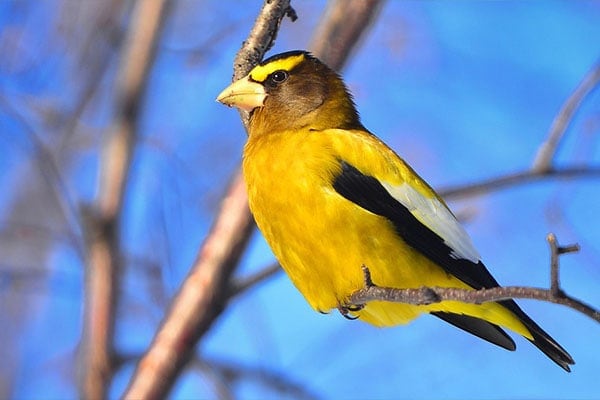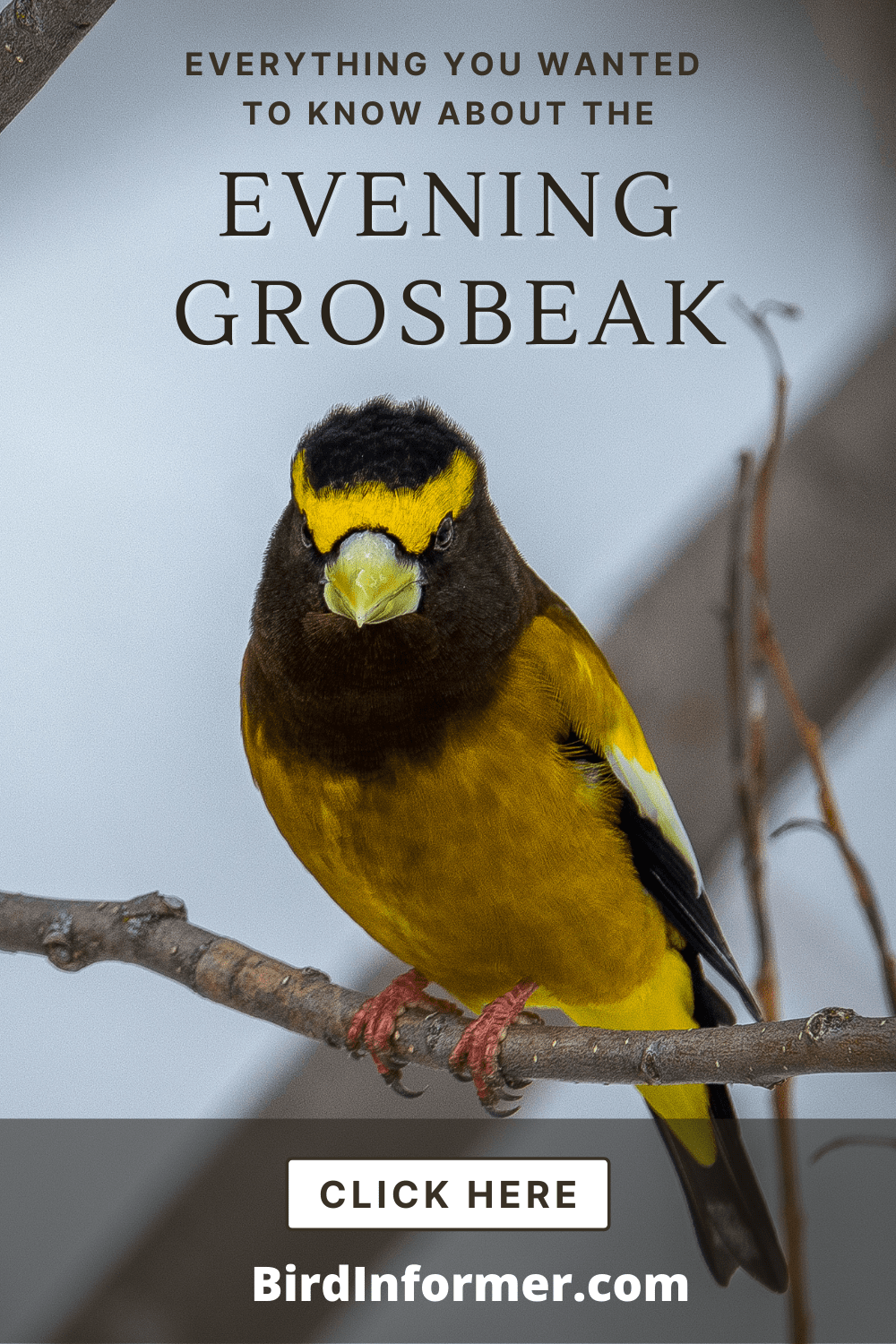Contents
- Evening grosbeak facts
- Evening grosbeak: how-to identify
- Evening grosbeak bird vocalization
- Where You’ll See Evening Grosbeaks
- Evening grosbeak diet
- Evening grosbeak nesting
- Evening grosbeak behavior
- How-to attract evening grosbeaks
- Evening grosbeak threats
- Evening grosbeak fun & interesting facts
- Evening grosbeak related species in this family
The Evening Grosbeak is a large finch that wears a rich-golden color. They are fascinating to watch in winter when they usually gather in large flocks, filling the area with bright yellow color. As their name implies, these birds feature a large beak that they use to crush seeds, which they usually forage high in trees.
In this article, we are going to cover a wide variety of topics related to the Evening Grosbeak, such as:
- How to identify them
- How, when, and where they migrate
- Their diet
- How and where they nest
- And much more…
So, without any more delay…
Let’s jump right into it and learn more about the Evening Grosbeak.
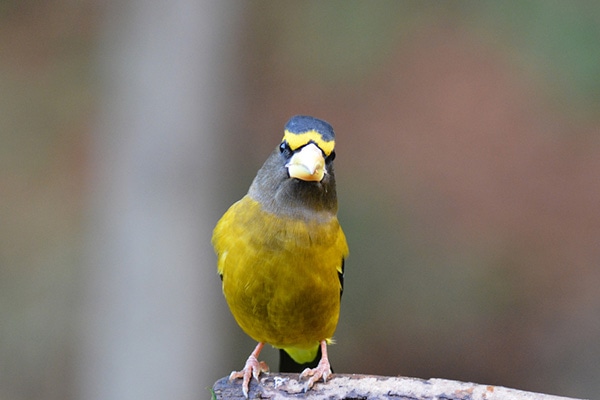
Evening grosbeak facts
- Common Name: Evening Grosbeak
- Scientific Name: Coccothraustes vespertinus
- Scientific Family: Fringillidae
- Life Span: 15 years
- Size: 6.3 to 7.1 inches
- Wingspan: 11.8 to 14.2 inches
- Weight: 1.9 to 2.6 oz
- Conservation status: Least Concern (LC)
Evening grosbeak: how-to identify
Evening Grosbeaks are medium to large-sized finches with a heavy-looking body. They are known for their grossly large, thick, conical bills, generally where their name came from. Added to that, their tails are short, the chest is large, and the necks are thick.
Differences Between Male & Female
Evening Grosbeaks are dimorphic birds, which means male and female birds look very different from each other.
Male Evening Grosbeaks wear a more colorful pattern than the female birds. The first thing you’ll notice is the rich-golden color in the males’ body and forehead areas. Their head is a dark brown color, while their wings and tail areas are black with white patches.
Female Evening Grosbeaks are duller compared to the males. The only yellow part in this bird is the back of the neck. The rest of their bodies are grayish, with the upper parts darker than the underparts. They also have black wings and tails with white patches.
Differences In Summer Plumage vs Winter Plumage
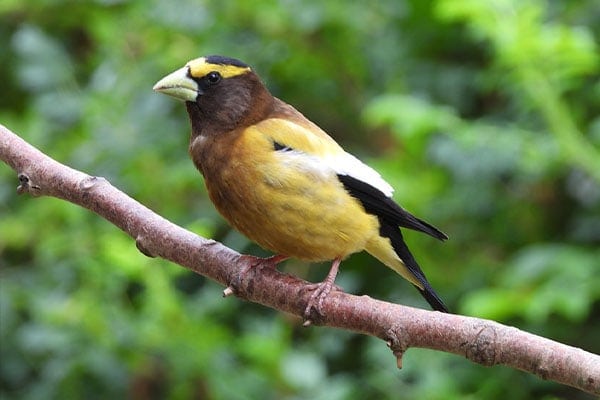
Evening Grosbeaks look the same throughout the year, regardless if it’s the summer or winter season.
Evening grosbeak bird vocalization
Where You’ll See Evening Grosbeaks
Evening Grosbeaks mainly breed in the southern part of Canada, going down to northern California, and going east to New Hampshire. This is also where they mostly stay year-round. But some birds do travel throughout other parts of the US in winter, except in Florida.
These birds prefer to breed in coniferous forests and mixed woods across North America. Once winter comes, the birds would move to lower elevations and open environments with lots of shrubs. They would also frequently visit bird feeders for food.
Evening grosbeak bird migration
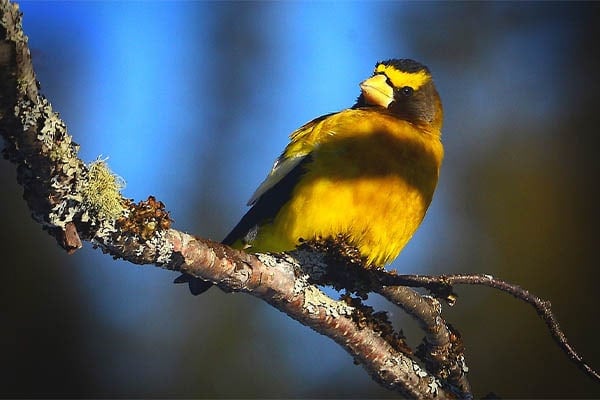
Evening Grosbeaks are known to be irregular migratory birds. This means that they don’t have a particular pattern followed, and migration is usually influenced by the abundance of food, particularly crops in coniferous forests.
They would usually stay in Canada and the northern United States throughout the year. But if the food supply is low, they would usually move south for winter, but not too far from their breathing grounds.
Evening grosbeak diet
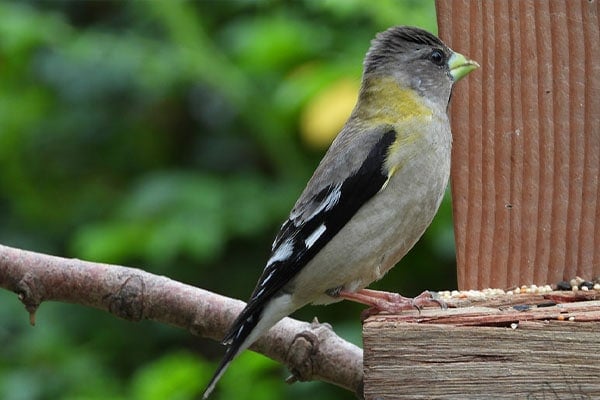
The diet of Evening Grosbeaks consists primarily of seeds. This includes seeds from maple, ash, cherry, pine, apple, and bindweed trees. They would also eat some fruits like cherries, juniper berries, crabapples, and snowberries.
The large beaks of these birds are mainly designed to crush the seeds they get. At the same time, it can assist in removing the skin and flesh of fruits.
In summer, you’ll see these birds eat some insects, including caterpillars, aphids, and spruce budworm larvae. They are also frequent visitors of backyards to consume large amounts of sunflower seeds.
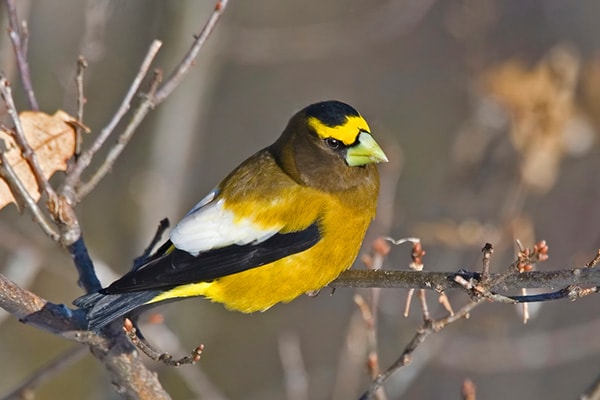
Evening grosbeak nesting
- Clutch Size: 2-5 eggs
- # of Broods: 1-2 broods
- Incubation Period: 12-14 days
- Nestling Period: 13-14 days
- Egg Description: Pale Blue to Blue-Green with brown or purple blotches
Most Evening Grosbeaks are monogamous birds. However, in cases where food sources are abundant, polygamy may occur.
Pairs are usually formed before they get to the breeding grounds. These birds will then nest in high trees or shrubs at the height of 10-100 feet above the ground. Males are usually the ones who pick the site while the females build the nest.
The female birds are also the ones who gather the materials to build the nest. Twigs are collecting from the grounds, or they would break them from twigs. They would then create a loose cup using these twigs and line them with softer materials like grasses, moss, pine needles, and rootlets.
Evening grosbeak behavior
Evening Grosbeaks are very social birds, especially in winter. They would usually forage together, and you’ll even notice that they can be very noisy. Once the breeding season starts, the birds separate into pairs or small groups.
It has been noted that Evening Grosbeaks can be aggressive throughout the year, even in winter, but only when food is scarce. They would do anything to defend their feeding grounds, and at some point, when the food source is minimal, they would leave and find another territory instead.
How-to attract evening grosbeaks
Evening Grosbeaks have a very unpredictable migration pattern. So, you might need to catch them during the summer in their breeding grounds.
Attracting these birds can be very simple. If there’s one thing they love to visit in bird feeders, it’s the sunflower seeds. Fill your bird feeders with sunflower seeds and hang them around the area you’ve chosen. This can be your backyard or their natural habitat.
You can also hang a suet feeder for an additional food source. Other bird seeds you can serve are safflower seeds and maple seeds.
Evening grosbeak threats
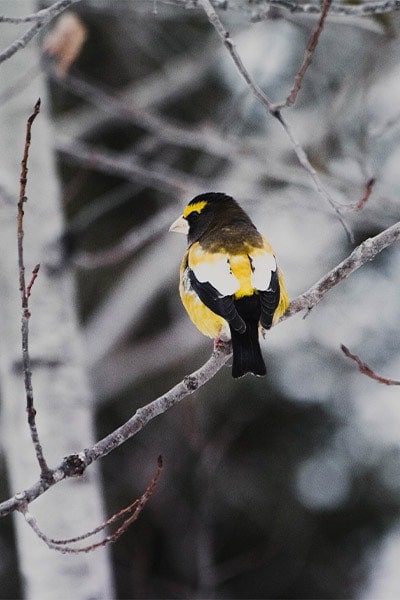
Although still common and widespread, Evening Grosbeaks are slowly declining in numbers and are at risk of extinction.
Logging, forest developments, disease outbreaks, and pesticide poisoning are some of the reasons for the population decline. Climate change has also altered landscapes and contributed to the decrease in natural habitats.
Evening grosbeak fun & interesting facts
- Evening Grosbeaks are named after their large beaks.
- They are ferocious seed crackers.
- These birds can eat large quantities of salt.
- They don’t have a distinct sound.
- It was observed that the birds could eat 96 sunflower seeds in a minute.
- They are collectively called “gross” of grosbeaks.
- The oldest recorded Evening Grosbeak was 16 years and three months old.
- Pine Grosbeak
- Gray-crowned Rosy-Finch
- Black Rosy-Finch
- Brown-capped Rosy-Finch
- House Finch
- Purple Finch
- Cassin’s Finch
- Common Redpoll
- Hoary Redpoll
- Red Crossbill
- Cassia Crossbill
- White-winged Crossbill
- Pine Siskin
- Lesser Goldfinch
- Lawrence’s Goldfinch
- American Goldfinch

